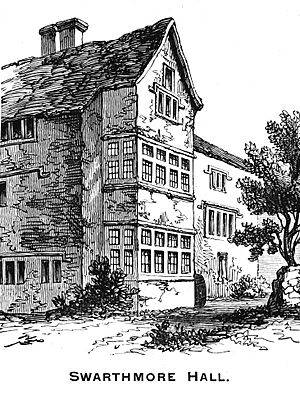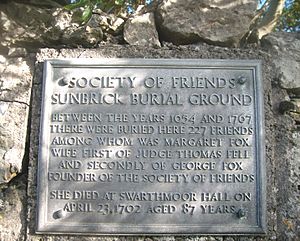Margaret Fell facts for kids
Quick facts for kids
Margaret Fell
|
|
|---|---|
 |
|
| Born |
Margaret Askew
1614 Kirkby Ireleth, Lancashire
|
| Died | 23 April 1702 (aged 87–88) |
| Occupation | theologian, writer |
| Known for | founder of the Religious Society of Friends |
| Spouse(s) | Thomas Fell (1632 – d. 1658), George Fox (1669 – d. 1691) |
| Children | Sarah Fell, et al. |
Margaret Fell (born Askew, later Fox) was a very important woman who helped start the Religious Society of Friends, also known as the Quakers. She was born in 1614 and lived until 1702. Many people called her the "mother of Quakerism" because of her big role in the early days of the movement. She was also one of the "Valiant Sixty," a group of early Quaker leaders who traveled and shared their beliefs. Her daughters, Isabel and Sarah, also became important Quaker leaders.
Contents
Margaret Fell's Early Life and Family
Margaret Askew was born at Marsh Grange in a place called Kirkby Ireleth in Lancashire, England. In 1632, she married Thomas Fell, who was a lawyer. They moved to a home called Swarthmoor Hall.
Thomas Fell became a Justice of the Peace in 1641. This meant he was like a local judge or official. He also became a member of the Long Parliament in 1645, which was a very important group of lawmakers in England. Margaret and Thomas had seven daughters and one son. Most of their children, and Margaret herself, became Quakers.
How Margaret Fell Became a Quaker
In 1652, a man named George Fox visited Swarthmoor Hall. He was a traveling preacher who shared new ideas about faith. Margaret Fell wrote that George Fox "opened us a book that we had never read in." He taught them about the "Light of Christ" inside everyone. This idea meant that people could find God's guidance within themselves.
Soon after, Margaret and many people in her home became Quakers. Swarthmoor Hall became a busy center for the new Quaker movement for the next six years. Margaret helped by being like an unofficial secretary. She sent and received letters from Quaker missionaries who traveled to spread their message. She also helped raise money for those on missions.
After her husband Thomas died in 1658, Margaret continued to live at Swarthmoor Hall. It remained a safe place for Quakers, even when the government sometimes raided it.
Standing Up for Religious Freedom
Margaret Fell was one of the few early Quakers who came from a wealthy family. Because of this, she often helped other Quakers who were arrested or treated unfairly. After King Charles II came back to power in England, Margaret traveled to London in 1660 and 1662. She asked the King and Parliament to allow people to have freedom to choose their own religion. She argued that Quakers wanted to change the world through peaceful ideas, not violence.
In 1664, Margaret Fell was arrested. She was accused of not taking an oath and for letting Quakers meet in her home. She bravely said that as long as she had a home, she would worship God in it. She was sent to Lancaster Gaol (a prison) for six months. After that, she was sentenced to stay in prison for life and lose her property.
She remained in prison until 1668. During this time, she wrote many religious pamphlets. One of her most famous works is "Women's Speaking Justified." In this short book, she argued that women should be allowed to preach and lead in religious matters. She believed that God created everyone, so both men and women could have the "Inner Light" and be prophets.
Later Life and Continued Work
Margaret was released from prison by the King's order. In 1669, she married George Fox, the Quaker leader she had met years before. After her marriage, she was again put in prison for about a year for breaking the Conventicle Act. This law made it illegal for groups of people to meet for religious services that were not approved by the government.
Soon after she was released, George Fox went on a religious trip to America. When he returned in 1673, he was also imprisoned. Margaret traveled to London again to help him. He was finally freed in 1675.
After this, Margaret and George spent about a year together at Swarthmoor Hall. They worked together to defend the way the Quaker community was organized, especially the separate meetings for women.
George Fox spent most of his later life traveling or in London, and he died in 1691. Margaret Fell continued to live at Swarthmoor Hall. She outlived both of her husbands and remained active in the Quaker Society even in her eighties. She died on April 23, 1702, at the age of 87. She was buried in an unmarked grave at the Quaker burial ground in Sunbrick.
Today, a room at Friends House in London, UK, is named after Margaret Fell.
Margaret Fell's Writings
Margaret Fell wrote or helped write at least 23 different works. Most of these were short pamphlets. Some of her early writings, like False Prophets, Antichrists, and Deceivers, were written soon after she became a Quaker in 1655.
Some of her longer works, such as A Call to the Universall Seed of God (1665), Womens Speaking Justified (1666), and A Touch-Stone: or, A Perfect Tryal by the Scriptures (1667), were written while she was in prison.
After she died, some of her works were collected and published in a book called A Brief Collection of Remarkable Passages and Occurrences (1710). This book was very long, but it still only contained a small part of her writings and letters. Today, you can find her works in special online collections or in modern books that gather important historical writings.
Images for kids








